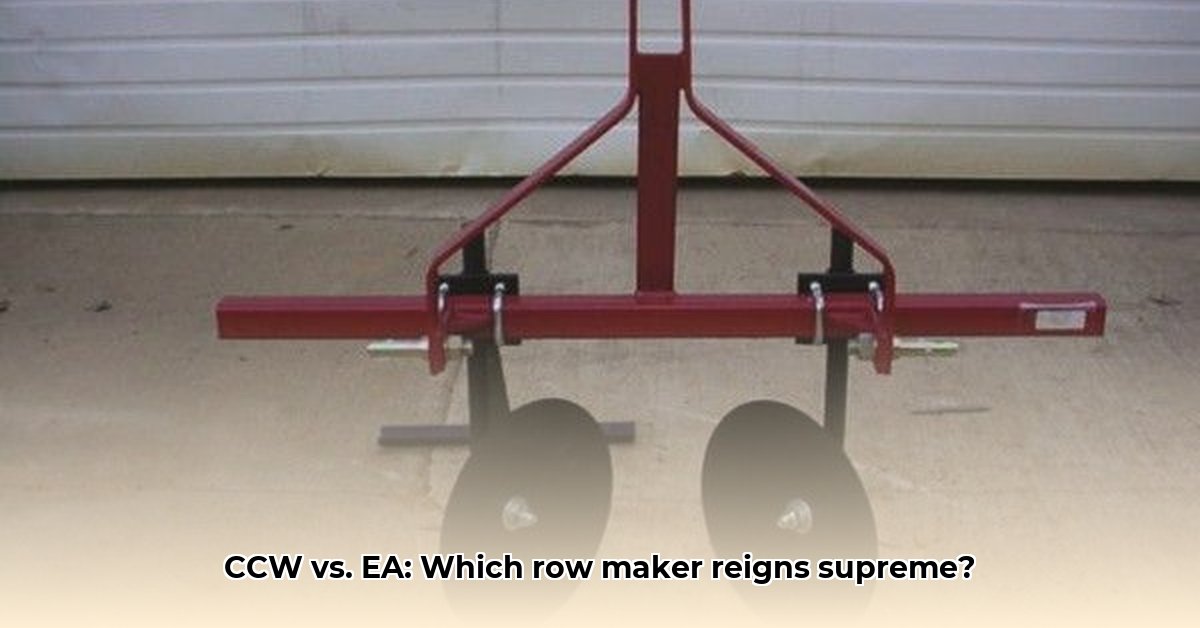
Choosing the Right Tool for Raised Bed Gardening
Building raised garden beds offers numerous advantages for sustainable agriculture: improved drainage, enhanced soil health, and increased time efficiency. But creating these beds efficiently requires the right tools. This comparison review examines two popular tractor-powered row makers: Cottage Craft Works (CCW) and Everything Attachments (EA), helping you choose the best option for your needs. Whether you're a seasoned farmer or a gardening novice, this guide provides the information you need to make an informed decision. For more detailed tractor techniques, see this helpful guide: Tractor Row Making.
Cottage Craft Works Row Builder: A Closer Look
The CCW Garden Line row builder is designed for smaller tractors, typically within the 12-30 horsepower range. Its compact design makes it ideal for smaller gardens or farms where maneuverability is critical. It's praised for its user-friendly design and relatively quick setup.
Pros:
- Efficiency: Quickly creates raised beds, saving valuable time.
- Ease of Use: Simple assembly and intuitive operation are ideal for beginners.
- Positive User Feedback: Generally receives positive reviews for its ease of use, although some users highlight shipping concerns.
Cons:
- Shipping Issues: Reports of damaged units due to packaging have surfaced, leading to potential delays and frustration.
- Limited Adjustability: Offers fewer customization options compared to the EA model, which could restrict its suitability for diverse soil types or highly specific ridge heights.
Everything Attachments Row Maker: The Versatile Option
The Everything Attachments tractor garden bedder is a more robust option, designed for a wider range of tractors and conditions. It's more akin to a heavy-duty workhorse, offering greater versatility and durability.
Pros:
- Durability: Built to withstand tough conditions and provide long-term use.
- Adjustability: Provides more control over settings, allowing customization to suit various soil types and desired bed dimensions. A wider range of application.
- Modification Potential: Users have reported successfully modifying the attachment to enhance its capabilities. Long-term flexibility is high.
Cons:
- Higher Cost: The initial investment is higher than the CCW model, although this may be offset over time by its durability.
- Steeper Learning Curve: The increased adjustability and features require a more significant learning curve compared to the CCW option.
Head-to-Head Comparison: CCW vs. EA
The following table summarizes the key differences between the CCW and EA row makers to aid your purchasing decision. Remember to check manufacturer websites for the latest pricing information.
| Feature | Cottage Craft Works (CCW) | Everything Attachments (EA) |
|---|---|---|
| Price | Varies; check website | Varies; check website |
| Horsepower Compatibility | 12-30 HP | Wider range; check specifications |
| Build Quality | Moderate | High |
| Shipping Method | Needs improvement; potential damage | Typically packaged securely |
| Ease of Assembly | Relatively easy | Moderate |
| Adjustability | Limited | High |
| Warranty | Consult manufacturer website | Consult manufacturer website |
Building Raised Beds: A Step-by-Step Guide
This section provides a general guide. Always consult your specific row maker's manual for detailed instructions and safety precautions. These steps are designed for a broad range of tractors and row makers.
Step 1: Site Preparation
Clear the area of debris, rocks, and weeds. Level the ground for uniform row creation. Consider sun exposure and water access when planning row placement.
Step 2: Attaching the Row Maker
Carefully follow the manufacturer's instructions for attaching the row maker to your tractor's three-point hitch. Ensure all connections are secure.
Step 3: Depth Adjustment
Adjust the depth based on soil type and desired bed height. Sandy loam requires less depth than heavier clay soils. Start shallow and gradually increase.
Step 4: Creating the Rows
Drive the tractor slowly and consistently. Overlapping passes may be necessary for higher rows. Maintain a constant speed for uniform results.
Step 5: Final Adjustments
Inspect the rows, making minor adjustments as needed. Any unevenness should be minimal if previous steps are done correctly.
Safety Precautions: Always wear appropriate safety gear. Take your time and maintain a steady speed. Regularly inspect your equipment for any issues. Be aware of obstacles in the tractor's path.
Risk Assessment and Mitigation
Potential risks include shipping damage (especially with CCW) and operational issues due to improper use or equipment malfunction. Mitigation strategies include purchasing shipping insurance for CCW, careful pre-operation checks, adhering to the manufacturer's instructions and taking your time.
Conclusion: The Best Row Maker for You
The optimal choice depends on individual needs and budget. Consider your tractor's horsepower, soil type, garden size, and budget. The CCW option excels in ease of use, but the EA model offers heightened durability and adjustability. Prioritize reading user reviews and comparing specifications before purchasing.